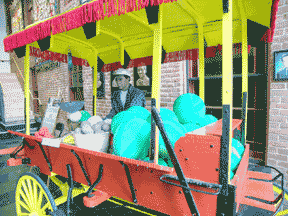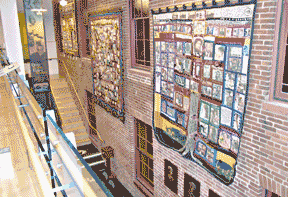 |
||||||||||
|
||||||||||
|
||||||||||
Commemorating Disappearing Communities
|
||||||||||
 |
Arabbers lived in northern Anne Arundel County and sold their produce in Baltimore. |
An exhibit at Banneker-Douglass Museum in Annapolis documents what communities had, their pride and desire to remember the past shared by African Americans in the rapidly changing towns near Baltimore-Washington Thurgood Marshall International Airport.
Banneker-Douglass Museum is Maryland’s only state museum preserving African American culture. Trails, Tracks, Tarmac preserves the memory of African Americans who lived in Northern Anne Arundel County as far back as 1850. They are the generations that held together family, church and community in a time and place of rapid change.
Current generations still put time, effort and love into creating this exhibit. Their intention was to document this rich past while people still remembered it.
A Heritage of Place
Beginning in the 1850s, African Americans built communities and lives centered on work, churches and schools in small towns near what is now BWI Airport. As these places — Matthewstown, Pumphrey, Queenstown, Marley Neck, Furnance Branch and Freetown are some of them — change or are gobbled up by suburban development, people wanted to commemorate the “little towns that are disappearing,” according to Banneker-Douglass director Wendi Perry. They wanted to “preserve and pass along their history.”
Many Stories
This exhibit tells many stories. One story – told through a legal document from the days of slavery – shared how a free black man purchased the freedom of his wife and daughter — with a down payment and installments.
Another story tells how people made their living:
Back in my days when we started off, all the poor people, mostly women, did domestic work; there wasn’t any other work for them. When we got old enough, we went to work. We worked by the week most of the time, and only had a half-day on Sunday off. Then, first thing Monday morning we’d be back on the job again, recounted Sarah Lucille Wright Cook of Dorsey.
Another documents reasons affirmative action became national policy:
Blacks in professional positions often suffered the indignity of having to train newly hired white colleagues that you knew would eventually be your boss. … Blacks could not depend on regular promotional opportunities. … It was difficult to listen to white coworkers discuss the number of promotions they had already received while I was still doing the same job for many years — and I trained them, recounted Curtis Warren Dorsey, who worked at the National Security Agency.
Another describes the pains of integrating white schools:
I was really a non-entity at Arundel [Senior High School] until they announced I was the valedictorian, and that was the only time I felt that kind of anger. … I felt it more from the principal … than some of the students. … I don’t think the guidance counselor ever talked to me, recounted Sharon Witherspoon, whose military family had lived in many places before she transferred into Arundel High. An attorney in Washington, D.C., Witherspoon graduated from Harvard Law School,
My coach encouraged me to go to college and helped me get in. … In talking to a lot of my friends who went to school with me, pretty much blacks were ignored as far as trying to get into college. They steered you to business. The guys went to class to learn how to run a business and they found out it was just doing typing, recounted Lloyd ‘Butch’ Kaiser, who graduated from Brooklyn Park High School to the U.S. Naval Academy.
There are things to see: An Arabber’s wagon (Arabbers didn’t come from Baltimore, but traveled to Baltimore from northern Anne Arundel County), a model train set and railroad track-laying tools (many men worked on the railroad in the early years), 19th century china and the tokens that farm workers received instead of money and that were redeemable only at the farmer’s own store.
Artist Cisco Davis created a story-telling mural showing the people, places and events in the long history of the region.
Crafted by Many Hands
These stories and more were recorded by the Northern Arundel Cultural Preservation Society. Guided by the museum staff, “23 really dedicated people” of the Society, Perry says, not only interviewed people sharing their memories but put the whole exhibit together. They wrote text, searched sheds and attics for tools and “hot curlers,” arranged displays and even built the platform for the model train and the tool shed.
The enthusiasm and support was “awesome,” said Amelia Harris, Banneker-Douglass’ educational and exhibit specialist. Many people who helped with the exhibit are educators, some retired, and some still teaching, Harris said.
This was the first time the Banneker-Douglass Museum developed an exhibit with an outside community group. “They have set a high standard,” said Perry.
Stitching Together a Rich Heritage
As many people joined together to create the exhibit, some worked side by side under the guidance of Dr. Joan M.E. Gaither, a fabric artist, to create some extraordinary quilts, the most eye-catching part of the exhibit.
Brightly colored, asymmetrical, rich in symbolism, the 10-by-nine-foot quilts hang from the wall rising to the second floor, demanding your attention. These quilts go beyond traditional patterns to combine elements of story telling, scrapbooks and pictorial art.
One quilt depicts the Trails, Tracks and Tarmac theme of the exhibit.
Another quilt, My Spiritual Family Quilt, honors the members of Gaither’s church, the Saint Mark United Methodist Church of Hanover. The family appears in transfer photographs of more than 600 church members, those living and those who have passed.
Accompanying these large quilts are more than 20 smaller quilts, most about three feet by three feet, hanging in the historic Mount Moriah Church adjacent and connected to the museum.
Fittingly, many of these quilts honor the churches that remain centers of religion and community even as people move to other cities and suburbs. Many churches host annual homecomings that are well attended by people who have moved away.
Fabric-transfer photographs, sort of a photographic scrapbook in fabric, make up many of these quilts. Gaither, who teaches at the Maryland Institute of Art, taught her neighbors the technique to document church, family and community histories, schools and even local baseball teams.
The exhibit is worth seeing and not only for the spectacular and unusual quilts. It is an exhibit that shows the efforts that came from people’s hearts.
The Banneker-Douglass Museum, 84 Franklin Street, Annapolis, is open Tu-Sa10am-4pm. free: 410-216-6180. Programs and activities complement the exhibit monthly through November. On March 24, ladies wearing hats and gloves gather for formal tea from noon-3: free with rsvp.
Ben Miller, retired museum curator with the National Park Service, is Bay Weekly’s museum reviewer.
|
Current Issue \\ Archives \\ Subscriptions \\ Clasified Advertising \\ Display Advertising |
© COPYRIGHT 2007 by New Bay Enterprises, Inc. All rights reserved.